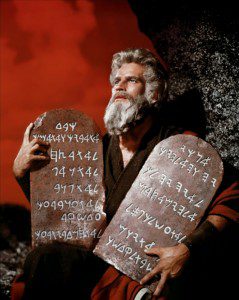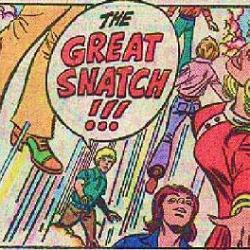Nicolae: The Rise of Antichrist; pp. 156-161
Buck Williams is trying to reach former-rabbi Tsion Ben-Judah, but Ben-Judah is in hiding. So Buck turns for help to Moses and Elijah.
Moses and Elijah are characters in this story. Moses Moses and Elijah Elijah. As in Mt.-Sinai, Ten-Commandments Moses and Mt.-Carmel, fiery-chariot Elijah. The very same. They’ve mysteriously come back to life and returned to Earth. And now they are both, like Tsion Ben-Judah, born-again Rapture-Christians.

I know we’ve mentioned all of that before, but sometimes it’s helpful just to step back and let it sink in again how deeply weird it is that Moses and Elijah are characters in this story.*
Tim LaHaye wants his readers to recognize that he, Tim LaHaye, is uniquely correct about the meaning of the Bible and of “Bible prophecy,” and so his story includes Moses and Elijah as characters who stand around preaching that Tim LaHaye is uniquely correct about the meaning of the Bible and of Bible prophecy. They stop just short of mentioning LaHaye by name, but still.
Anyway, Buck takes a cab to the Temple Mount, where Moses and Elijah have been holding court, and before he arrives there we get one last flashback/summary/review reintroducing these two characters to any readers who may have forgotten them.
They called themselves Moishe and Eli, and truly they seemed to have come from another time and another place. They wore ragged, burlap-like robes. They were barefoot with leathery, dark skin. Both had long, dark gray hair and unkempt beards. They were sinewy with bony joints and long muscled arms and legs. Anyone who dared get close to them smelled smoke.
So either this is Moses and Elijah from the Bible, or it’s Willie Nelson and Kris Kristofferson.
Those who dared attack them had been killed. It was as simple as that. Several had rushed them with automatic weapons, only to seem to hit an invisible wall and drop dead on the spot.
The rules clearly state that there’s a penalty for using range weapons in melee.
Others had been incinerated where they stood, by fire that had come from the witnesses’ mouths.
Note the plural here. The authors suggest that this has happened more than once, publicly. And they’ve previously told us that one such incident was filmed by not-CNN and broadcast around the world.
Set aside the laws of physics here. Yes, of course this bit of the story violates the laws of physics — that’s the authors’ point. But what the authors fail to see is that this bit of their story also violates every known law of human nature. The people in their story are not people — not anything recognizable as the humans that we know.
They’ve just described a scene in which the entire population of the world witnesses a series of explicit, undeniable and unambiguously supernatural events. And then everyone simply ignores them. No awestruck wonder. No curiosity. No skeptical probing to try to figure out how the trick was done. Just a giant collective shrug. That’s impossible. Humans don’t work like that.
But according to the authors, humans do work like that. Or, at least, Christ-denying, unsaved, non-RTC, damnation-deserving humans do. In their view, unbelievers are not simply unconvinced, but obstinate, willful deniers of evidence every bit as overwhelmingly clear as the miraculous fire-breathing killers in this story. (Just read Josh McDowell or any other “apologetics” book — it’s obvious, so anyone who doesn’t immediately convert is just stubbornly rejecting what they know to be true.)
They preached nearly constantly in the language and cadence of the Bible, and what they said was blasphemous to the ears of devout Jews. They preached Christ and him crucified, proclaiming him the Messiah, the Son of God.
If they’re sticking to “the language and cadence” of that part of the Bible, it wouldn’t sound blasphemous to the ears of devout Jews. It would sound like first-century koine Greek — an indecipherable babble even in a tri-lingual city like Jerusalem.
The only time they had been seen apart from the Wailing Wall was at Teddy Kollek Stadium …
Jerry Jenkins is so proud of the one piece of lazy research he bothered to do that he can’t resist repeating it every chance he gets. Yes, Teddy Stadium is a real place in Jerusalem. And Moses and Elijah, apparently, are football fans.
The only time they had been seen apart from the Wailing Wall was at Teddy Kollek Stadium, when they appeared on the platform with Rabbi Tsion Ben-Judah, a recent convert to Christ. News coverage broadcast around the world showed these two strange men, speaking in unison, not using microphones and yet being heard distinctly in the back rows. “Come nigh and listen,” they had shouted, “to the chosen servant of the most high God! He is among the first of the 144,000 who shall go forth from this and many nations to proclaim the gospel of Christ throughout the world!”
That “come nigh” and “go forth” business is what the authors actually meant by “the language and cadence of the Bible.” For the authors, the language of the Bible is English — but only English as it was spoken before Friedrich Schleiermacher was born.
But even if you read the Bible in King James English, it’s hard to explain how Ben-Judah could be counted among the “144,000” mentioned in the book of Revelation. “These are they which were not defiled with women; for they are virgins,” Revelation 14:4 says. And yet, verily and forsooth, the authors themselves hath written that Ben-Judah had taken unto him a wife, and gone in to her and knew her and uncovered her feet, and lo, in the fullness of time, she bore unto him many children.
The authors review how Ben-Judah then spent the following year on a stadium tour around the world, “resulting in tens of thousands of converts,” before the recent slaughter of his family which drove the ex-rabbi into hiding. And that brings us back to the present in our story, with Buck approaching the Western Wall to seek help from “Moishe and Eli” in tracking down Ben-Judah.
This evening the witnesses were doing as they had done every day since the signing of the treaty between Israel and Carpathia: They were proclaiming the terrible day of the Lord.
And if that made you think of this, then your brain works the same way mine does.
And they were acknowledging Jesus Christ as “the Mighty God, the Everlasting Father, and the Prince of Peace.”
So Moses and Elijah haven’t become orthodox Christians — they’ve become Monarchian heretics. (Hey, I’m not judging. I lean more than a bit Patripassian, myself.)
Buck was always thrilled and moved by the preaching of the witnesses. He looked around the crowd and saw people from various races and cultures. He knew from experience that many of them understood no Hebrew. They were understanding the witnesses in their own tongues, just as he was.
French-speaking people heard the witnesses speaking in King James French. Spanish-speakers heard King James Spanish, Mandarin-speakers heard King James Mandarin. …
Buck creeps closer until he catches their attention:
Both stared directly into his eyes, and he could not move. Without gesturing or moving, Eli began to preach. “He who has ears to hear, let him hear! Do not be afraid, for I know that you seek Jesus who was crucified. He is not here; for He is risen, as He said.”
Believers in the crowd mumbled their amens and their agreement. Buck was riveted. Moishe stepped forward and seemed to speak directly to him. “Do not be afraid, for I know whom you seek. He is not here.”
Back in the first book the authors established this pattern of having the Two Witnesses speak almost entirely in direct quotations from the Bible. That seemed like a timid choice — a way of side-stepping the precarious challenge of writing dialogue for characters who are supposed to be speaking on God’s behalf.
Here that choice creates a problem, since Buck is coming to them with a specific, extra-biblical question — “Do you guys know where I might find our friend Tsion?” That question seems to require a specific answer involving something other than a hodge-podge of Bible passages plucked out of context.
The authors solution is to have the Two Witnesses speak in a “clever” biblical code. “I know whom you seek,” Moishe says to Buck, winking broadly. “Eh, get it? Whom you seek? Like, it seems like I’m only quoting from Matthew 28, but really I’m also talking about Tsion … get it?”
But Buck doesn’t get it.
Moishe, still staring at Buck: “Indeed He is going before you into Galilee. There you will see Him. Behold I have told you.”
I supposed this is slightly more subtle than having Moishe tell Buck that “ion-Tsay is in alilee-Gay.” But only slightly. Yet despite such broad hints, Buck still takes a while to pick up on all this winking and elbow-nudging:
The witnesses stood and stared silently for so long, unmoving, it was as if they had turned to stone. The crowd grew nervous and began to dissipate. Some waited to see if the witnesses would speak again, but they did not. Soon only Buck stood where he had stood for the last several minutes. He couldn’t take his eyes off the eyes of Moishe. The two merely stood at the fence and stared at him. Buck began to advance on them., coming to within about 20 feet. They seemed not even to be breathing. Buck noticed no blink, no twitch.
“Jeez, kid,” Moishe whispered. “Galilee. Tsion’s in @%#$ Galilee. How many times’ve I gotta say it? Now get lost before you draw any more attention to yourself.”
That’s what I wish happened here, but what actually does happen is even sillier:
In the fading twilight, he carefully watched their faces. Neither opened his mouth, and yet Buck heard, plain as day in his own language, “He who has ears to hear, let him hear.”
And, finally, Buck gets it.
So then, two questions:
1. If you can communicate telephathically, why wouldn’t you do that first instead of speaking out loud in a heavy-handed Bible “code” that your dim friend still can’t quite grasp? And,
2. If you’re communicating telepathically, why are you still speaking in Bible code?
– – – – – – – – – – – –
* Why Moses and Elijah? Well, in LaHaye’s idea of the End Times, they will be the “Two Witnesses” whose story is told in Revelation 11.
We should note that Revelation itself never names those Two Witnesses, and that they seem to appear much later in that story than they do in LaHaye’s chronology. Revelation gives us the seven seals of divine wrath, then the first six of the seven trumpets, and then the Two Witnesses show up, but for LaHaye they appear before any of those divine judgments even begin. He can explain why that is, mind you, and if I had several hours to spare and access to the dozens of charts, graphs and decoder rings necessary to explain it, I could show you how he does that and how it almost makes a kind of internal sense given the whole vast, convoluted premillennial dispensationalist framework. But for now let’s just note this as another reminder that LaHaye’s insistence that he sticks to a “literal” reading of the Bible should not be mistaken for a claim that he sticks to anything like a linear reading of it.
The idea of identifying John of Patmos’ two unidentified witnesses with Moses and Elijah is an old one. It’s an old guess more than a “tradition,” since apart from modern “prophecy scholars” like LaHaye, it was never suggested as more than speculation. That guess is inspired by the strange story in the Synoptic Gospels of Jesus’ “transfiguration,” which describes Jesus’ encounter with those two patriarchs. Moses and Elijah carry great symbolic weight there as the embodiments of “the law and the prophets,” respectively, although that symbolism has always bothered me a bit, since Jesus himself said otherwise, repeatedly. The embodiment of the law and the prophets, Jesus said, is love.












